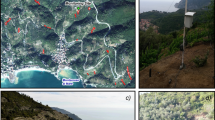Abstract
Rainfall, soil properties, and morphology are major factors controlling shallow landsliding. A series of meteorological events that triggered soil slips in northern Italy were studied to define rainfall thresholds and to evaluate a possible regionalization. Soil properties, triggering rainfall, and local lithological and morphometrical settings of different sites were used as input to an infiltration model. The approach allows the recognition of several triggering conditions in the Piedmont, Pre-Alpine and Alpine regions. This suggests the need for different rainfall thresholds with respect to those derived with other methods. Intensity versus rainfall duration relationships become particularly important when related to soil permeability and thickness, and demonstrate the role of antecedent precipitation. Events with exceptional water discharge from obstructed road culverts reveal the role played by anthropic structures in triggering such phenomena. Different approaches to slope stability analysis are shown, taking into account bedrock lithology, topography, seepage, and local saturation conditions.
Similar content being viewed by others
Author information
Authors and Affiliations
Additional information
Received: 23 October 1997 · Accepted: 25 June 1997
Rights and permissions
About this article
Cite this article
Crosta, G. Regionalization of rainfall thresholds: an aid to landslide hazard evaluation. Environmental Geology 35, 131–145 (1998). https://doi.org/10.1007/s002540050300
Issue Date:
DOI: https://doi.org/10.1007/s002540050300




